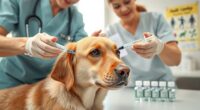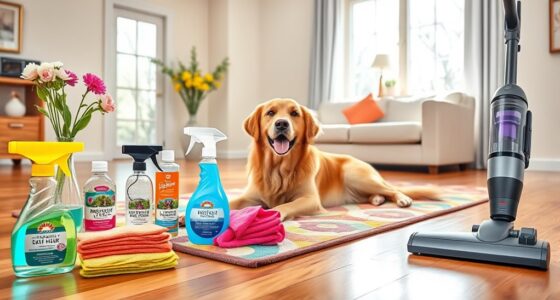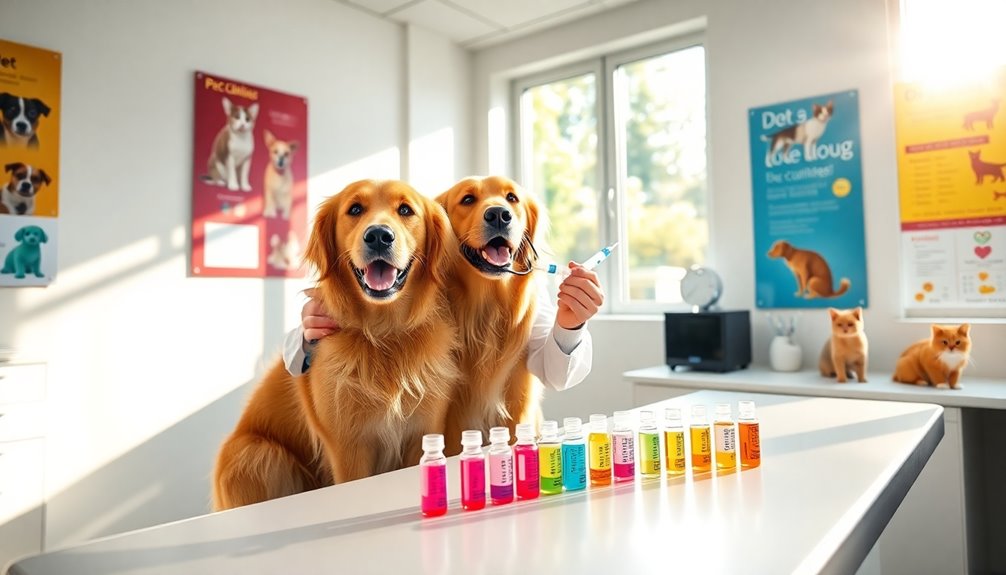To keep your dog healthy and happy, focus on proper grooming. Brush short coats weekly and long or curly coats several times a week to prevent mats. Trim nails carefully using the right tools, and aim to avoid the quick. Brush teeth regularly with dog-friendly products to prevent dental issues. Give baths as needed and dry thoroughly. For full details on each step and tips, you’ll discover how to make grooming smooth and effective.
Key Takeaways
- Regular brushing suited to your dog’s coat type prevents mats, reduces shedding, and promotes healthy skin.
- Trim nails carefully every few weeks using proper tools to prevent discomfort and injury.
- Brush teeth daily with dog-specific products and provide dental treats to prevent plaque buildup.
- Bathe your dog with lukewarm water and gentle shampoo, then dry thoroughly to maintain coat health.
- Establish a grooming schedule every 4-8 weeks and seek professional help for difficult areas or breed-specific needs.
Understanding Your Dog’s Coat and Proper Brushing Techniques
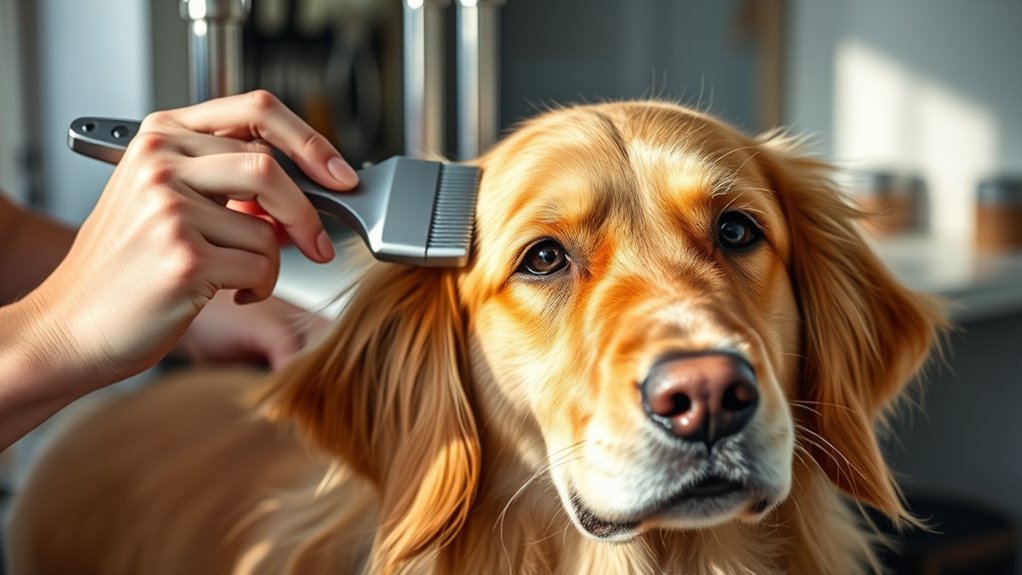
To properly groom your dog, it’s essential to understand their coat type and how to brush it effectively. Different coat types—such as short, long, curly, or wiry—require specific care. For short coats, brushing once a week helps remove loose hair and dirt, preventing matting. Long-haired breeds need more frequent brushing, ideally several times a week, to avoid tangles and mats. Curly coats, like poodles, benefit from gentle, thorough brushing every few days to maintain their texture. Wiry coats may need regular brushing combined with stripping or trimming. Adjust your brushing frequency based on your dog’s coat type, ensuring you keep their coat clean, healthy, and free of mats. Proper brushing not only enhances their appearance but also promotes good skin health. Regular grooming also provides an opportunity to check for skin issues and address them early. Being familiar with coat types and their specific grooming needs can significantly improve your dog’s overall comfort and wellbeing. Additionally, understanding the benefits of grooming can motivate consistent care.
Nail Trimming: Tools and Tips for Safe and Effective Grooming
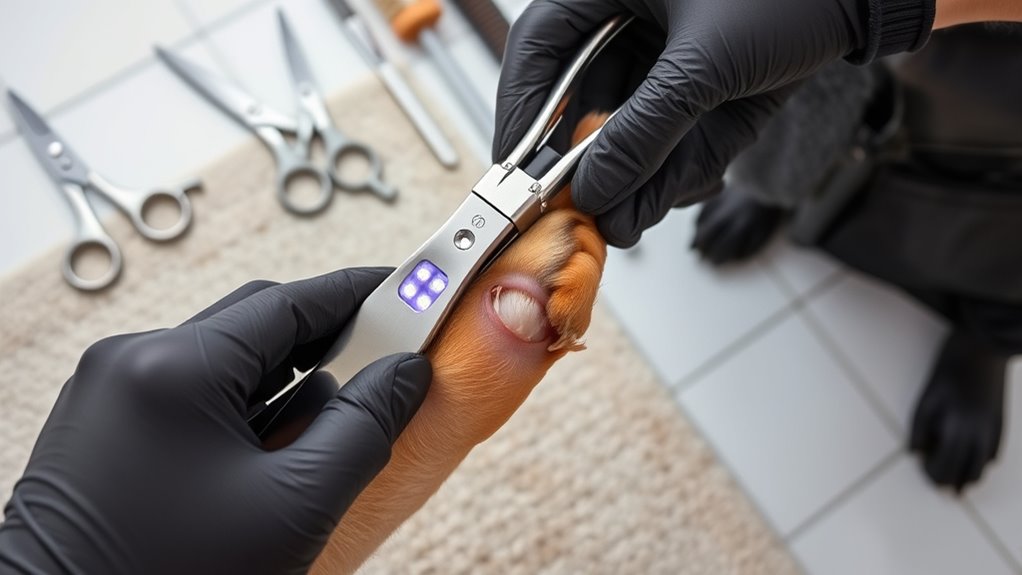
Trimming your dog’s nails is an essential part of grooming that helps prevent discomfort and health issues. Using the right nail grooming tools guarantees safety and efficiency. To achieve nail trimming safety, always choose sharp, well-maintained clippers designed for dogs. Here are some tips to improve your technique:
Trimming your dog’s nails prevents discomfort and health issues with proper, safe tools.
- Select appropriate tools, like guillotine-style or scissors-style nail clippers, based on your dog’s size and nail thickness.
- Trim small amounts at a time, avoiding the quick (the sensitive area inside the nail) to prevent bleeding and pain.
- Keep your dog calm by offering treats and praise, making nail grooming a positive experience.
- Incorporating professional grooming practices can further ensure safety and comfort during nail trimming.
- Regularly inspecting your dog’s nails and understanding AI-powered data analytics can help you determine the optimal trimming schedule. Additionally, staying informed about animal health research can guide best grooming practices for your pet’s well-being. Understanding grooming safety protocols is also crucial to prevent injuries during the process. Utilizing advanced grooming tools can improve precision and reduce stress for your dog.
Maintaining Dental Hygiene: Brushing and Dental Care Products

Regularly brushing your dog’s teeth is one of the most effective ways to maintain their oral health and prevent issues like bad breath, plaque buildup, and gum disease. Use a dog-specific toothbrush and toothpaste to guarantee safety and comfort. Consistent brushing helps reduce dog breath and keeps bacteria at bay. Along with brushing, consider dental care products like dental sprays or gels that can support oral hygiene. Incorporate dental treats into your routine to naturally clean teeth and freshen breath between brushings. These treats are designed to reduce plaque and promote healthy gums. Remember, maintaining a regular dental routine not only improves your dog’s breath but also contributes to their overall well-being. Dental health is an essential aspect of pet care that should not be overlooked. Using professional dental care techniques can further enhance your dog’s oral hygiene. Regular use of specialized products such as dog-friendly dental gels can help maintain fresh breath and prevent dental issues. Incorporating consistent routines into your grooming schedule can make dental care easier and more effective. Electric power generation methods, such as using bike generators, can even be a fun way to teach older children about sustainable energy. Stay consistent, and your dog will enjoy healthier teeth and fresher breath.
Bathing and Drying: Making Your Dog Comfortable and Clean
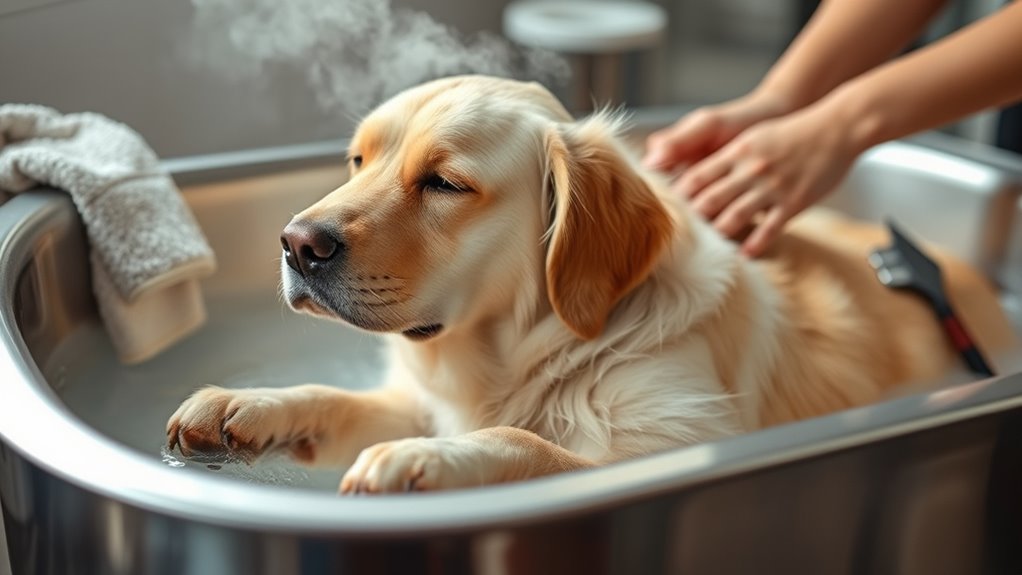
Bathing and drying are vital steps in keeping your dog clean and comfortable, helping to remove dirt, loose hair, and odors. Start by thoroughly wetting your dog with lukewarm water, then apply a gentle dog shampoo, massaging it into their coat. Rinse completely to prevent residue. Afterward, towel drying is essential to soak up excess water and keep your dog warm. To guarantee a thorough dry, follow these tips:
- Use multiple towels if needed to absorb moisture efficiently.
- Gently pat and avoid vigorous rubbing to prevent skin irritation.
- Consider a pet-safe blow dryer on a low, cool setting for faster drying, especially for long-haired breeds.
- Choosing a proper drying method ensures your dog stays comfortable and reduces the risk of skin issues.
- Implementing professional grooming techniques can further enhance your dog’s coat health and appearance.
- Regular grooming and coat maintenance help prevent matting and skin problems, promoting overall health. Additionally, paying attention to your dog’s skin condition during grooming can help identify early signs of health issues, ensuring prompt veterinary care when needed.
Grooming Schedule and When to Seek Professional Help

Establishing a consistent grooming schedule is essential to keep your dog healthy and looking their best, but knowing when to handle grooming at home or seek professional help can be tricky. Most dogs benefit from regular baths, nail trims, and dental care, often every 4 to 8 weeks. However, certain breeds with long or thick coats may require more frequent attention. Recognize signs that your dog needs professional grooming, such as mats, excessive shedding, or difficulty managing nails and hair. If you’re unsure or uncomfortable, don’t hesitate to schedule a professional grooming session. A groomer can address problem areas safely and efficiently, ensuring your dog stays comfortable, healthy, and well-maintained. Regular grooming and professional help when needed keep your dog happy and looking great. Additionally, understanding your dog’s specific coat type can help tailor a grooming routine, making maintenance easier and more effective. Proper grooming techniques can also prevent skin issues and discomfort. Incorporating specialized grooming services like coat, nail, and dental care can further enhance your pet’s well-being.
Frequently Asked Questions
How Often Should I Change My Dog’S Grooming Routine as They Age?
As your dog ages, you should adapt their grooming frequency based on their changing needs. Regularly evaluate their coat, nails, and teeth, and increase grooming sessions if you notice matting, difficulty walking, or dental issues. Age-related grooming ensures comfort and health, so stay attentive to signs your dog needs more or less care. Keep their grooming routine flexible, and consult your vet for personalized advice as your dog grows older.
Are There Breed-Specific Grooming Needs I Should Be Aware Of?
Think of your dog’s breed as a unique book, each chapter needing special attention. Breed-specific grooming is essential because different breeds have distinct coat types, grooming techniques, and nail or dental care needs. For example, a Poodle requires regular trimming, while a Bulldog needs more frequent ear cleaning. Staying aware of these needs guarantees you give your furry friend the right care, keeping them healthy and happy.
Can Grooming Help Prevent Certain Health Issues in Dogs?
Grooming can definitely help prevent health issues in dogs. Regular brushing and bathing keep their skin healthy, reducing the risk of skin infections. Consistent dental care, like brushing teeth and professional cleanings, helps prevent dental disease. Plus, trimming nails prevents discomfort and injuries. By maintaining a grooming routine, you catch potential problems early, ensuring your dog stays happy, healthy, and free from common issues like skin infections and dental disease.
What Are Signs My Dog Is Stressed During Grooming?
Your dog’s stress signals can be as obvious as a fireworks display. During grooming, watch for signs like trembling, excessive panting, yelping, or trying to escape—these are classic grooming signs of dog anxiety. If your pup seems overwhelmed or becomes unusually clingy afterward, it’s a clear indication they’re stressed. Recognizing these signs helps you make grooming a calmer, more positive experience, preventing long-term anxiety issues.
How Do I Choose the Right Grooming Products for Sensitive Skin?
When choosing grooming products for sensitive skin, you should look for hypoallergenic shampoos and natural grooming products. These are gentle and minimize irritation, helping your dog stay comfortable during grooming. Always read labels carefully to avoid harsh chemicals. Test a small amount first to see if your dog reacts. Opt for products specifically formulated for sensitive skin, ensuring a soothing experience that keeps your dog healthy and happy.
Conclusion
Keeping your dog looking great is crucial, but don’t forget that their health matters just as much. While regular grooming can prevent issues like matting and bad breath, neglecting it can lead to discomfort and costly vet visits. Think of grooming as both a loving routine and an essential health check. By staying consistent, you’ll strengthen your bond and ensure your furry friend stays happy, healthy, and comfortable every day.


